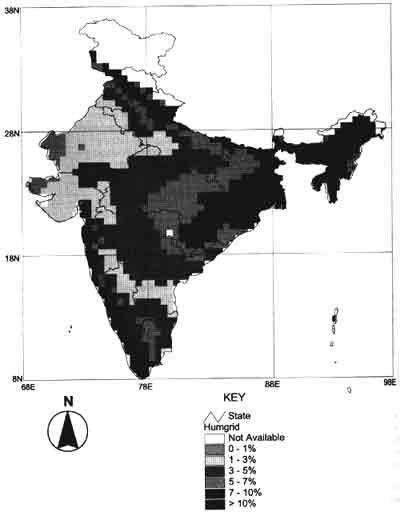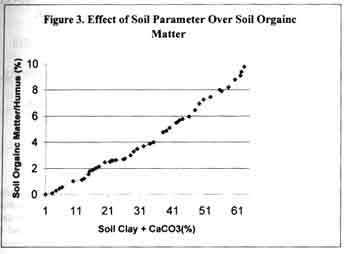| GISdevelopment.net ---> AARS ---> ACRS 1997 ---> Poster Session 1 |
Assessing biologically
Degraded Soil : A GIS approach
Satya Priya and Ryosuke
Shibasaki
Global Engineering laboratory
Institute of Industrial Sciences, The University of Tokyo
7-22-1, Roppongi, Monato-ku, Tokyo 106, Japan
Fax : 81-3-3479-2762
E-mail :satya@shunji.iis.u-tokyo.ac.jp
Abstract Global Engineering laboratory
Institute of Industrial Sciences, The University of Tokyo
7-22-1, Roppongi, Monato-ku, Tokyo 106, Japan
Fax : 81-3-3479-2762
E-mail :satya@shunji.iis.u-tokyo.ac.jp
It is practically impossible for man to produce stable humus synthetically. Man can only properly cultivate the field, supply organic matter and encourage the development of stable humus in the soil. Soil with stable humus must always be protected to maintain the fertility and productivity. Stable humus is the crucial center, the focus of the soil life cycle. Adhering to farming practices that assure the production of stable humus becomes the farmer's main objective. In this paper, the authors discuss the various steps involved in assessing the biological state of the soil, by calculating humus content.
1. Introduction
For nearly one hundred years soil science in most schools of higher learning especially in agricultural sciences has been primarily concerned with the physical and mechanical aspects of soil structure. Biological thinking or biologically degraded soil has become a major concern only in last few years. The new approach consider not only the physical properties and mineral structure of the soil, but also the process by which organic matter is transformed into humus by microorganisms. Good soil consists of 90% mineral and 10% bio-organic substances. The bio-organic parts consists of 70-90% humus, 10-30% roots, and active fraction, which constitutes living organisms and other, constitutes as shown in Figure 1.

Figure 1: Composition of Organic Matter (Source, E. G. Gregorich et al.; 1995)
Some of the nutrients get lost through leaching due to continually wet weather, melting snow, flooding or through denitrification. Also each cultivated plant takes away nutrients from the soil, as soon as the crops are harvested. The substantial task for the farmer is to take care in returning nutrients taken from the soil through harvesting. The conventional farmer is uses water soluble, mostly salty chemical fertilizer. In contrast, the bio-organic farmer uses organic matter in the form of crop residues, and other wastes, and/or compost, in order to take of soil life, its proliferation and simulation to highest effectively. Microbial soil compound plays one of the most important roles in the decomposition of organic litter. Soil organic matter includes plant and animal remains in various stages of decomposition, cells and tissues of soil organisms, and substances produced by the soil microbes. Well- decomposed organic matter forms humus-a dark brown, porous, spongy material with a pleasant, earthy smell. The occurrence of microorganisms in the soil depends on many factors e.g. on soil acidity, air and soil humidity, air and soil temperature, soil water, all meteorological factors etc.
Seeing an importance of soil biology this study only considers the mineralization of organic matter without erosion. A distinction is made between non-resistant organic matter (i.e. fresh organic residues) and resistant organic matter (humus). The biological degradation dealt in this study is as mineralization of resistant organic matter mainly based and soil parameter, which calculates the decay rate of humus.
2. Study Area
The chosen study are in this study is India, lies to the north of equator, between 8o4' and 37o6' North and 68o7' and 97o25'. East It is bounded in the south by the Indian Ocean, in the west by the Arabian Sea, in the east by Bay of Bengal, in the north-east, north and a part of the north-west by Himalayan ranges, and the rest of the north-west by the Great Indian Desert.
Physiographically, India can be divided into seven regions: the Northern Mountains, constituting the Himalayan ranges; the great Indo-Ganagetic Plain; the Central Highlands; the peninsular Plateau in the states of maharashtra, Andhara pradesh, Karnataka and Tamil nadu; the East Coast; the West Coast; and the Island. The average elevation of the plateau that dominates most of Peninsular India ranges between 300 and 1800 m. The river systems of India may be broadly classified into two groups: the Himalayana and the Deccan. The main rivers of the Himalayan group, which are snow-fed, are the Indus, Ganga and Brahmaputra including their major of the country. The Deccan system include the west-flowing Narmada, Tapi and Periyar and the east-flowing mahandi, Godavari, Krishna, Penneru and kaveri.
The Republic of India's mainland stretches 3214 kms from north to south and 2933 kms from west to east. The total land area is 3.29 million sq. kms. Size wise it is the sixth largest country in the world. India exhibits a variety of landscapes and climatic conditions in the evolution of different soils and vegetation. It shows a string relationship among the soils, climate and vegetation.
3.Methodology
3.1 Calculating soil Organic Matter/Humus Decay Rate
In general, the organic matter in the soil comes from plant and animal residues when organic matter decomposes, by the action of microorganisms and other forces. It produces substance and nutrient that helps to support plant life. Well -decomposed organic mater is called humus, which helps to hold moisture in the soil. In this study humification and mineralization are the two different combined processed used for quantifying the soil organic matter/humus decay in a year.
What is Humification?
Humification, the transformation of organic matter into humus leads to soil decay, is a fascinating process. Organic materials such as manure or field wastes, when disked into the upper six inches of topsoil will undergo several changes. The humification process involves first catabolism, then anabolism. These are not truly correct terms as they are usually used for same functions within living organisms, but we may soil as one living organism.
What is Mineralization?
Is the process of freeing minerals from organic molecules (carbon bonds). During humification there are two possible end products for atoms within the starting molecules. Minerals may either build up stable humus or be free in form; carbon either tied within humus or evolves in form of carbon dioxide. The following is a summary table of where atoms end up after humification.
| All minerals within organic compounds | 80% freed up and 20% in humus |
| Carbon from carbohydrates | 80% evolves as carbon dioxide and 20% goes to humus formation. |
| Nitrogen | Upto 50% will remain in humic form. |
3.2 Impact of Climatic Factor on Humus Decay Rate
Decomposition of organic matter is a function of microbiological activity, which is a function of temperature and soil moisture. The following equation has been used for calculating the rate of humus decay in percentage per year (Koepf, 1953).

Where,
t= mean air temperature during the month
P= precipitation
PET = potential evapotranspiration
K = the rate of humus decay in percentage by year
Leeman and Cramer (1991), aggregated terrestrial grid dataset of 30 year has been used for obtaining mean monthly temperature and Precipitation to calculate the humus decay. Using the same dataset, Potential Evapotranspiration, PET has been calculated.
PET was calculated using Throwaite (1948) method.
Where,
PET is in cm., T is the mean monthly Temperature (oC) and

Where,
Tj is the mean temperature of the jth month
I is heat index
Where,
a is an exponent
3.3 Soil Parameter
The rate of decay varies according to the texture of the soil, the nature of organic matter, and the pH, calcium carbonate and soil moisture. The annual loss of organic matter, as affected by calcium has been calculated using Remi's coeffcient (Remy and Marin-Lafleache, 1974)
| K= | 1200
--------------------------- (A + 200) (C+200) |
where,
A is clay in (%)
C is CaCo3 in (%)
K is the rate of humus decay in percentage per year
Digital FAO/UNESCO soil map of world, version 3.5 (1995), has been used to obtain and delineate the soil parameters for the purpose.
4. Results and Discussion
The result of calculating the humus decay rate by Koef equation is classified on the basis of their severity and value ranges. Six classes have been used. Following ratings were adopted in relation to the climatic index as shown in table 1 below. The rate of humus decay in percentage is mapped in Figure 2.

Figure 2: Annual Decay Rate of Humas in India
| Class | None to Very Slight | Slight to Moderate | Moderate to High | High to Very high | Very High to Severe | |
| Rating(%/yr.) | 0-1% | 1-3% | 3-5% | 5-7% | 7-10% | >10% |
Soil organic matter plays a central role in forming soil aggregates. Soils with high aggregate stability are more resistant to degradation by erosion and compaction. As the clay content of a soil increases, it requires a higher content of organic matter to maintain a given level of aggregate formation and stability. In this study it was found that, increase in clay and CaCO3 content of soil correspondingly shows possession of high organic matter as shown in figure 3. Soil organic matter acts as glue due to its polysaccharide content, holding soil particles in stable aggregates.

Figure 3: Effect of Soil Parameter Over Soil Orgainc Matter
The rate of decay varies according to the texture of the soil, being faster in a sandy than in a clay soil, the nature of the organic matter, the pH and water content above field capacity. Soil reaction between pH 5.0 and 7.5 has less effect on biological degradation. Slope aspect influences soil temperature and humidity, but slope angle has little influence on biological degradation. Altitude is taken into account by the climatic index, through its effect upon temperature.
5. Conclusion
The optimum organic matter content of soil depends on local climate, the amount and type of clay material present in the soil, and the soil, and the soil's intended use. Ideally, in a good-quality soil, all the functions of organic matter listed earlier operate fully. However, soil organic matter alone cannot supply the quantity and balance of nutrients required by crops under intensive production; fertilizer must be added to meet the crop's needs. On the other hand, soil needs optimum amounts of organic matter to maintain its structure and keep it in a tillable condition. The current study shows that the soil organic matter and humus decay rate content is an important component in assessing and maintaining the productivity of the soils. In coming days it is expected that concern of biologically degraded soil among the farmers and in soil science as a whole might a better way to make the soil healthier.
6. References
- Satya Priya and V.M. Salokhe, 1995; GIS Aided Land Evaluation for Crop Suitability Analysis - a case study. Informatics for Sustainable Agricultural Development Conference organized by National Information Center (NIC) New Delhi, India.
- Satya Priya and Ryosuke SIBASAKI, 1997; Application of GIS and RS for Land Cover Mapping - a case study, submitted in 5th International Conference in Urban Planning and Urgan Management, IIT, Bombay, India to be held on 16-19th of December.
- D.F. Action and L.J. Gregorich (editors) Center for Land and Biological Resources Research Branch Agriculture and Agri-Food Canada, Publication 1906/E, 1995.
- A Provisional Methodology for Soil Degradation Assessment, FAO, 1979.